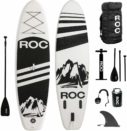Some people find it hard to decide the right answer to the question; what is better, inflatable, or hard paddleboard? Being able to decide between these two depends on your preferences as well as your needs. There are five factors you should consider when choosing between an inflatable SUP and hard paddleboard; these are:
- Portability
- Storage space
- Durability
- Performance
- Cost
Portability
Inflatables are the easiest type of paddleboard to transport — no need for a large truck, SUV, or van because when deflated, inflatables roll up to the size of a sleeping bag. A fantastic perk to inflatables is that you can easily fly with them when you go on vacation. Keep in mind that you will need to inflate and deflate your inflatable before and after you go paddling.
When transporting hard paddle boards, you will need a large car or car racks. Also, hard paddleboards weigh more, so they will be heavier to carry to and from the water. If you’re more of a load and go type of person, a hard paddleboard will be your best friend.
Storage Space
When deciding between an inflatable or a hard paddleboard, it’s essential to consider how much storage space your home has. If you live in an apartment or house with no garage (or minimal storage space), an inflatable will be your best option. You can store your inflatable virtually anywhere in your home.
When purchasing a hard paddleboard, you need to consider where you will be storing it during SUP season and the offseason. Yes, you could store it in your garage, but you still need to make sure you have plenty of clearance and room to maneuver your board (about 9 to 12 feet long) in and out of your home.
Durability
Inflatables are more durable than hard paddleboards. If you drop your inflatable by accident, it won’t ding or scratch. But if you drop your hard paddleboard, there’s a chance your board will be damaged and may need to be repaired immediately. If you want a carefree board, an inflatable will be your best option.
Since inflatables are more durable, they are the perfect board to use when white water paddling or paddling in rocky rivers.
Performance
When it comes to paddleboard performance, hard paddleboards provide optimal performance compared to inflatables. Hard boards are more agile, have better glide, and can catch waves easily when SUP surfing. In other words, hard paddleboards are the best option if you plan to use your paddleboard for SUP surfing, SUP racing, or long-distance expeditions.
Cost
If you’re on a budget, inflatables are typically less expensive than hard paddleboards. Inflatables allow for an affordable price-point, which makes them a good board for first-timers or families.
Final Thoughts
You’ll want an inflatable paddleboard if…
- You have minimal storage space
- You travel often and want to take your board with you
- You’re a first-timer or on a budget
- You’re an adventurous paddler and need a durable board
You’ll want a hard paddleboard if…
- You plan on only using it at local beaches, lakes, bays
- You want to catch waves & go SUP surfing
- You’re a load-and-go paddler
- You want optimal performance, agility, and speed when paddle boarding
One of the most significant differences between an inflatable paddleboard and a regular hard paddleboard comes down to your preference of convenience versus performance. As noted above, inflatable paddle boards are inherently more convenient due to their less demanding storage and transportation requirements. On the flip side, a traditional hard paddleboard, while not the most convenient, will surpass an iSUP’s performance since it has more agility and superior glide on the water. You can’t go wrong with either, but make sure to choose the right paddleboard that best matches your needs and preferences.





